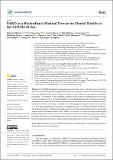| dc.contributor.author | Shibata, Takanori | |
| dc.contributor.author | Hung, Lillian | |
| dc.contributor.author | Petersen, Sandra | |
| dc.contributor.author | Darling, Kate | |
| dc.contributor.author | Inoue, Kaoru | |
| dc.contributor.author | Martyn, Katharine | |
| dc.contributor.author | Hori, Yoko | |
| dc.contributor.author | Lane, Geoffrey | |
| dc.contributor.author | Park, Davis | |
| dc.contributor.author | Mizoguchi, Ruth | |
| dc.contributor.author | Takano, Chihiro | |
| dc.contributor.author | Harper, Sarah | |
| dc.contributor.author | Leeson, George W. | |
| dc.contributor.author | Coughlin, Joseph F. | |
| dc.date.accessioned | 2021-10-25T19:19:29Z | |
| dc.date.available | 2021-10-25T19:19:29Z | |
| dc.date.issued | 2021-10 | |
| dc.date.submitted | 2021-10 | |
| dc.identifier.issn | 2071-1050 | |
| dc.identifier.uri | https://hdl.handle.net/1721.1/133119 | |
| dc.description.abstract | The COVID-19 pandemic is spreading across the globe, and it could take years for society to fully recover. Personal protective equipment (PPE), various hygiene measures, and social distancing have been implemented to reduce “human to human” contact, which is an essential part of outbreak prevention. The pressure of the pandemic combined with decreased communication and social contact have taken a toll on the mental health of many individuals, especially with respect to anxiety and depression. Effective use of robots and technology as a substitute for—or in coordination with—traditional medicine could play a valuable role in reducing psychological distress now more than ever. This paper summarizes the results of a comprehensive review of clinical research on PARO, a therapeutic seal robot, which has been used extensively as a biofeedback medical device and socially assistive robot in the field of mental health. PARO has proven to be an effective and economical non-pharmacological intervention method for both mental and physical well-being during the COVID-19 pandemic. Utilization of PARO during these times has provided more data for consideration and has helped in mitigating the negative stigma surrounding using robots in therapeutic settings. | en_US |
| dc.publisher | Multidisciplinary Digital Publishing Institute | en_US |
| dc.relation.isversionof | http://dx.doi.org/10.3390/su132011502 | en_US |
| dc.rights | Creative Commons Attribution | en_US |
| dc.rights.uri | https://creativecommons.org/licenses/by/4.0/ | en_US |
| dc.source | Multidisciplinary Digital Publishing Institute | en_US |
| dc.title | PARO as a Biofeedback Medical Device for Mental Health in the COVID-19 Era | en_US |
| dc.type | Article | en_US |
| dc.identifier.citation | Sustainability 13 (20): 11502 (2021) | en_US |
| dc.contributor.department | AgeLab (Massachusetts Institute of Technology) | |
| dc.contributor.department | Massachusetts Institute of Technology. Media Laboratory | |
| dc.relation.journal | Sustainability | en_US |
| dc.eprint.version | Final published version | en_US |
| dc.type.uri | http://purl.org/eprint/type/JournalArticle | en_US |
| eprint.status | http://purl.org/eprint/status/PeerReviewed | en_US |
| dc.date.updated | 2021-10-22T13:56:17Z | |
| dspace.date.submission | 2021-10-22T13:56:17Z | |
| mit.journal.volume | 13 | en_US |
| mit.journal.issue | 20 | en_US |
| mit.license | PUBLISHER_CC | |
| mit.metadata.status | Authority Work Needed | en_US |
